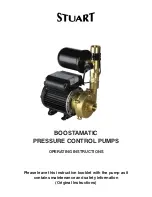
Maintenance
Confirm the seal chamber runout
The bearing housings are doweled to the casing (100) during the original build. However, in
order to assure the correct running position of the shaft, use this procedure in order to confirm
the seal chamber runout before you install the cartridge mechanical seals:
1. Install the old bearings on the shaft and bolt the bearing housings to the casing and head.
2. Mount the dial indicator on the shaft (122). Rotate the shaft (122) so that the indicator rides
along the seal chamber bore for 360°.
3. If the total indicator reading exceeds 0.005 in. (0.127 mm), determine the cause and make
corrections.
It may be necessary to readjust the housing.
a) Remove the dowel pins and use the adjusting screws to bring the runout to within 0.002
in. (0.0508 mm).
b) Redowel the housings in a different location.
4. Check the seal-chamber face runout.
a) With a dial indicator mounted on the shaft, rotate the shaft so that the indicator rides
along the seal-chamber face for 360°.
b) If the total indicator reading exceeds the allowable runout as this table shows,
determine the cause and make corrections.
Frame group
Nameplate radial
Maximum allowable total indicator
bearing
reading in inches (millimeters)
S/SX
6309
0.0020 (0.0508)
M / MX
6312
0.0025 (0.0635)
L / LX
6313
0.0030 (0.0762)
XL
6318
0.0035 (0.0889)
X, XX, XXL, XLX
6320
0.0035 (0.0889)
6224
5. Remove the dowel pins and unbolt the bearing housings. Discard the old bearings.
Assemble the thrust end (ball bearing pumps)
1. Assemble the inboard labyrinth seal (333A) into the inboard thrust end cover (160A):
a) Clean the end cover with a solvent.
b) Fit the labyrinth seal (333A) into the bore of the cover (160).
c) Tap the seal in with a hammer.
84
Model 3610, API Type BB1 API 610 11th Edition Installation, Operation, and Maintenance Manual
















































